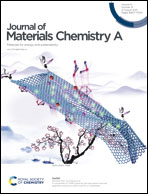Reduced interfacial tension on ultrathin NiCr-LDH nanosheet arrays for efficient electrocatalytic water oxidation†
Abstract
Reducing solid–liquid interfacial tension plays an important role in the realization of highly-efficient and stable electrocatalysis. Herein, we present a facile two-step hydrothermal method for the synthesis of ultrathin atomic-vacancy-confined NiCr-layered double hydroxide (LDH) nanosheet arrays (NiCr-LDH NSAs) to reduce solid–liquid interfacial tension, which leads to superior surface hydrophilicity and an extremely exposed catalytic active surface for highly-efficient water oxidation. The as-designed NiCr-LDH NSAs display an unexceptionable static contact angle of 17°, which corresponds to a significant reduction of 50% compared to NiCr-LDH (33°). As a result, the NiCr-LDH NSAs exhibits an ultra-low overpotential (η) of 182 mV at 20 mA cm−2 and a high mass activity of 317.0 A gNi−1 at η = 316 mV (200 mA cm−2), which is 20 times that of RuO2. By using X-ray absorption fine structure and operando synchrotron radiation infrared spectroscopies, we observe in experiment that the NiCr-LDH NSAs have numerous coordination-unsaturated NiO6−x active centers, which contributes to the effective adsorption of hydroxyl groups to form key *OOH intermediates and then accelerates four-electron reaction kinetics.



 Please wait while we load your content...
Please wait while we load your content...